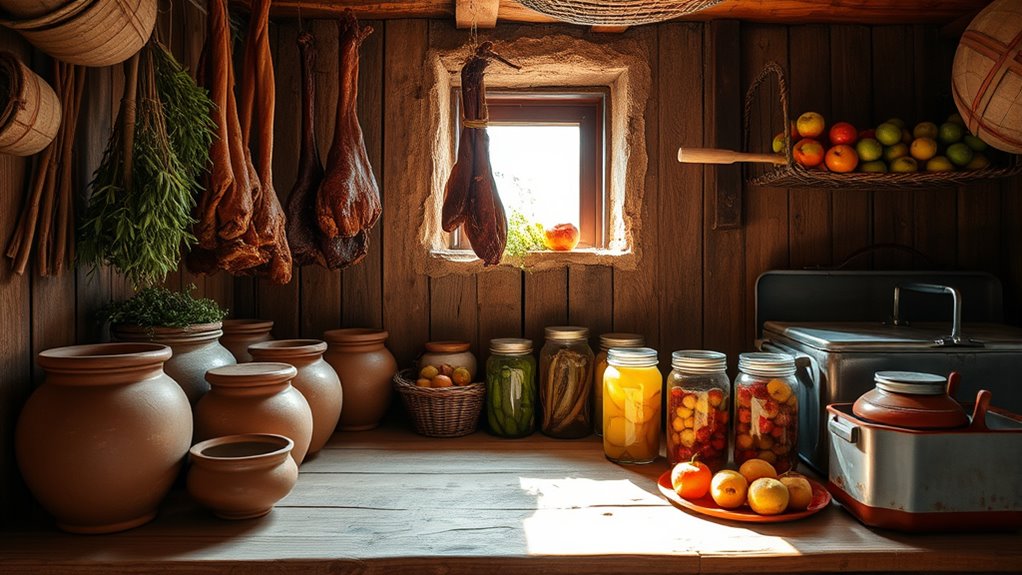To preserve food without refrigeration, you can dry or dehydrate fruits and vegetables to remove moisture, ferment produce to create a probiotic-rich environment, and salt or cure meats to draw out moisture and inhibit bacteria. Canning in jars or storing in cool, dark places like root cellars also helps. Smoking and storing foods in oil or vinegar further extend shelf life. For more tips, explore effective techniques to keep your food fresh naturally.
Key Takeaways
- Utilize drying and dehydrating methods to remove moisture and inhibit bacteria and mold growth.
- Employ fermentation techniques with beneficial bacteria to preserve foods and enhance probiotics.
- Use salting, curing, or brining to draw out moisture and prevent spoilage.
- Store foods in cool, dark, and well-ventilated environments like root cellars or insulated sheds.
- Apply proper canning and sealing techniques to create an airtight environment that extends shelf life.
Drying and Dehydrating Foods

Drying and dehydrating foods is one of the oldest and most effective methods of preservation, especially when refrigeration isn’t an option. You can turn fruits into tasty fruit leathers, which are lightweight, portable, and long-lasting snacks. Similarly, vegetables can be sliced thin and dried into crispy vegetable chips, perfect for on-the-go munching. To do this, you’ll need a dehydrator, oven, or sun-drying method. Properly drying removes moisture that bacteria and mold need to grow, extending shelf life profoundly. Make sure to cut your produce evenly for uniform drying. Once dried, store your fruit leathers and vegetable chips in airtight containers, away from light and humidity, to maintain freshness. This technique is simple, cost-effective, and keeps your food tasty without refrigeration. Using the right materials and techniques ensures your dried foods stay flavorful and safe for long-term storage. Additionally, choosing the appropriate drying methods can significantly impact the quality and longevity of your preserved foods. Proper food preparation also plays a crucial role in preventing spoilage during the drying process.
Fermentation Techniques for Food Preservation
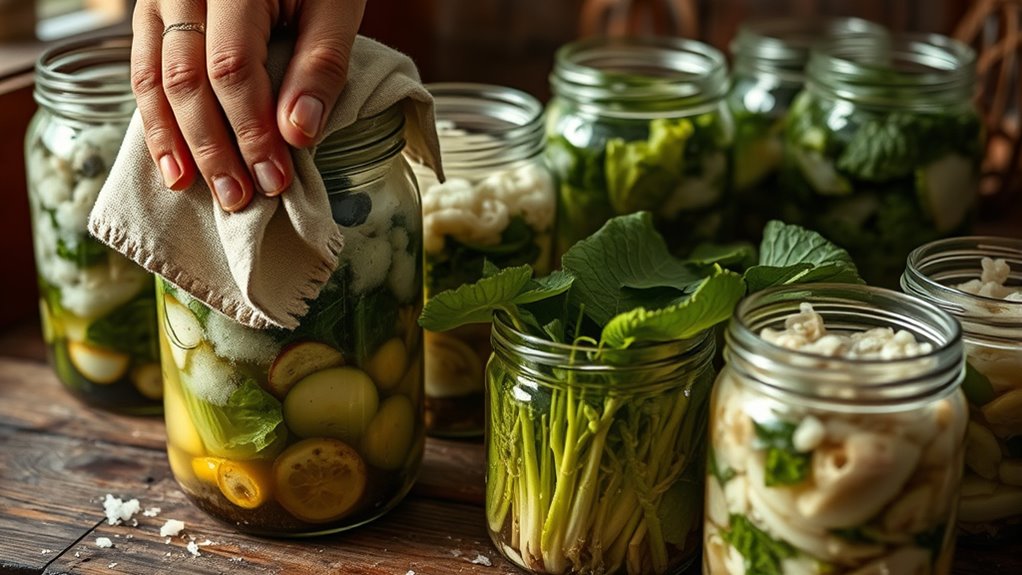
Fermentation is an ancient and reliable method for preserving food without refrigeration by encouraging beneficial bacteria to transform the natural sugars in produce. To start, you can use fermentation starters like whey, salt brine, or commercial cultures to kick off the process. These starters introduce the right bacteria to guarantee a successful fermentation. As fermentation progresses, the beneficial bacteria produce lactic acid, creating an environment that inhibits spoilage organisms. Not only does this extend the shelf life, but it also boosts probiotic benefits, supporting your gut health. You’ll want to keep the fermented food at a consistent, moderate temperature and monitor for bubbles and tangy flavors. Proper fermentation techniques help you preserve vegetables, dairy, and even beverages naturally and healthily without refrigeration. Additionally, choosing the right fermentation equipment can make the process more efficient and controlled.
Salting and Curing Methods
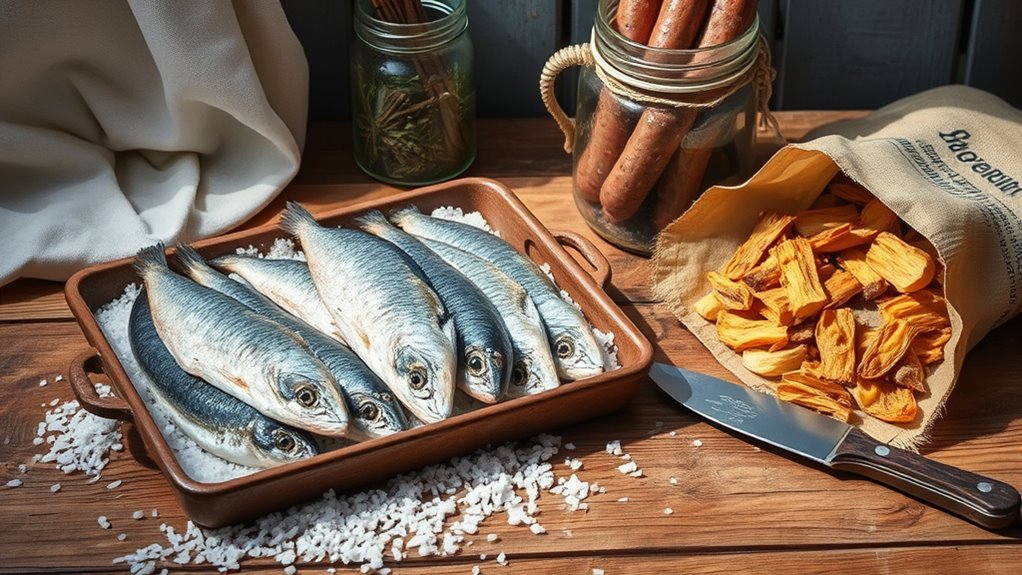
Salting and curing are effective ways to preserve food without refrigeration, but they require proper techniques. You need to understand how to apply salt correctly, choose the right curing method and duration, and store the food safely. Proper testing methodologies can help ensure your preserved foods stay safe and flavorful over time. Additionally, selecting appropriate curing materials and methods can prevent spoilage and ensure the longevity of your preserved foods, especially when utilizing traditional preservation techniques. Using the correct storage conditions can significantly extend the shelf life of cured foods, maintaining their quality and safety over time.
Salt Application Techniques
Salt application techniques are essential for preserving food without refrigeration, as they draw moisture out of the food and inhibit bacterial growth. To do this effectively, you need to control the brine concentration, ensuring it’s salty enough to extract moisture but not so salty that it ruins the flavor. Salt layering involves applying salt in multiple layers, pressing it into the surface to promote even curing. Start by thoroughly coating the food with salt, then add additional layers, focusing on areas prone to uneven drying. The key is consistent application, which creates an inhospitable environment for bacteria. Proper salt application not only preserves but also enhances flavor, making your preserved foods safe and delicious for longer periods without refrigeration. Additionally, understanding Kia Tuning techniques can help improve the quality and durability of certain preserved foods, especially those that benefit from controlled airflow and temperature. Incorporating modern preservation methods, such as salting, can further extend the shelf life and preserve nutritional value while maintaining traditional practices.
Curing Duration and Types
Choosing the right curing duration is essential to guarantee your preserved foods develop the desired flavor and safety. The curing duration varies based on the curing types you choose—salt curing, dry curing, or brining. Longer curing times intensify flavor and safety, but over-curing can lead to overly salty or tough textures. Shorter durations may not fully preserve or flavor the food. Use this table to guide you:
| Curing Type | Recommended Duration |
|---|---|
| Salt curing | 1 to 4 weeks |
| Dry curing | 2 to 6 weeks |
| Brining | 3 days to 2 weeks |
Adjust curing duration based on thickness, type, and desired flavor intensity. Proper timing guarantees safe, flavorful preservation.
Storage and Safety Tips
Proper storage is essential to guarantee your cured foods remain safe and flavorful over time. To prevent food spoilage, always keep salted and cured items in a cool, dry place away from direct sunlight. Use airtight containers or breathable coverings to limit exposure to moisture and pests. Properly curing and salting create a protective barrier that inhibits bacterial growth, but contamination prevention is still vital. Regularly check your stored foods for signs of spoilage, such as off odors or sliminess, and discard any questionable items. Keep raw and cured foods separated to avoid cross-contamination. Maintaining consistent storage conditions ensures your preserved foods stay safe, flavorful, and free from harmful bacteria, extending their shelf life without refrigeration. Additionally, understanding proper curing techniques can further enhance food safety and longevity, especially when combined with safe handling practices. Implementing proper storage methods can significantly reduce the risk of spoilage and ensure your preserved foods remain nutritious over time. Incorporating proper sanitation practices into your storage routine can also help prevent contamination and spoilage. Furthermore, monitoring storage environment conditions regularly helps maintain optimal preservation.
Canning and Jar Preservation
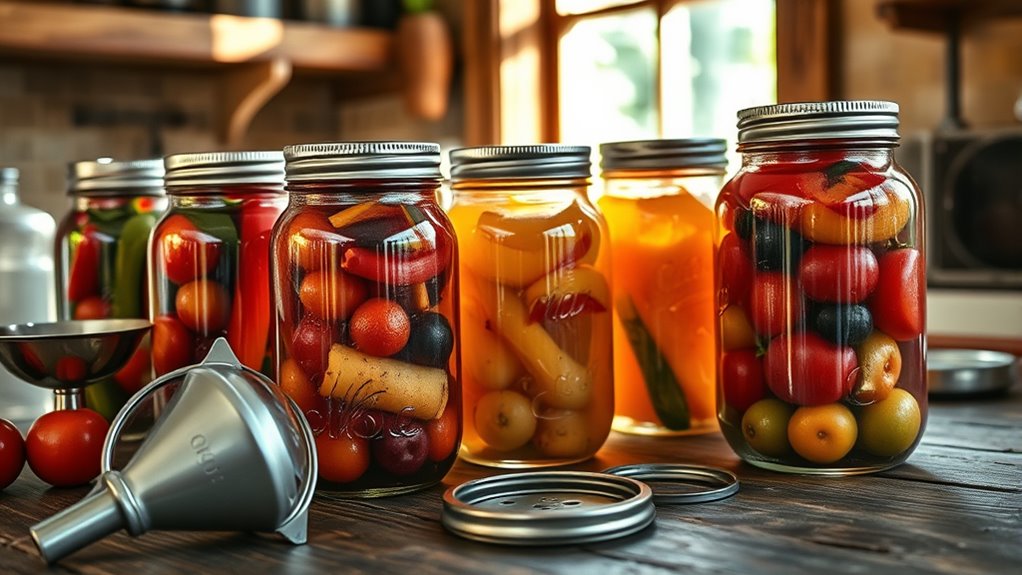
Canning and jar preservation offer effective ways to keep food edible without refrigeration by sealing it in heat-processed jars. To guarantee safety, start with thorough jar sterilization, removing any bacteria or contaminants. When you use pickling processes, you add vinegar or brine to preserve vegetables and fruits, creating an acidic environment that inhibits spoilage. Properly sterilized jars and lids are essential, as they form a tight seal that prevents air and bacteria from entering. Once filled with your prepared food, process the jars in boiling water or a pressure canner, depending on the item. This heat treatment destroys any remaining microorganisms, extending shelf life. Additionally, understanding food safety principles is crucial to prevent contamination and ensure your preserves remain safe to eat. Using proper storage techniques can further enhance the longevity of your canned goods. Employing airtight sealing methods during the canning process helps maintain the quality and safety of your preserved foods. Incorporating exclusion of air during sealing helps prevent spoilage and maintains quality. With careful technique, you can enjoy homemade preserves for months without refrigeration, maintaining flavor and safety.
Using Root Cellars and Cool Storage Spaces

Using root cellars and cool storage spaces can considerably extend the shelf life of harvested produce by keeping it at stable, low temperatures. Traditional root cellars utilize natural insulation and underground placement to maintain a consistent, cool environment ideal for storing root vegetables, cabbages, and apples. You can build or adapt a root cellar by choosing a shaded, well-ventilated spot and insulating it properly. Cool storage techniques also include using unheated spaces like basements, cellars, or insulated sheds that stay cool year-round. These methods prevent spoilage and preserve freshness without electricity. Proper airflow, humidity control, and regular monitoring are critical to maintaining ideal conditions. Monitoring conditions is essential for ensuring optimal storage environments and prolonging produce freshness. Maintaining the right temperature and humidity is key to preventing spoilage and extending storage life. Additionally, understanding storage environment factors can help optimize conditions further for different types of produce. Incorporating natural cooling methods can further enhance the effectiveness of traditional storage spaces.
Smoking Foods for Extended Shelf Life
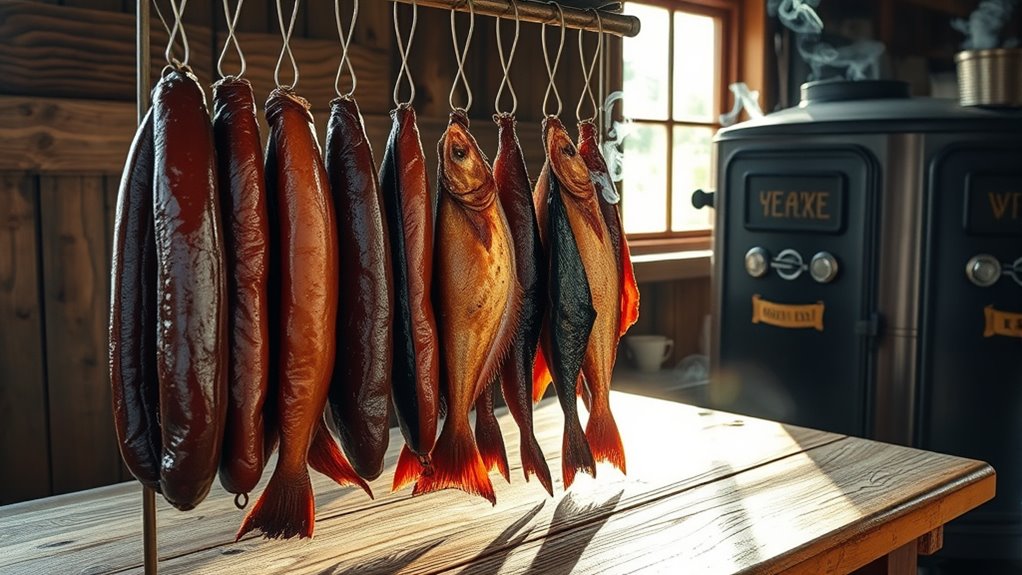
Smoking foods can markedly extend their shelf life, but choosing the right method is key. You’ll find that hot smoking and cold smoking each serve different purposes and require specific techniques. Certain foods, like fish, meats, and cheeses, respond best to smoking, helping you preserve them naturally without refrigeration. Additionally, understanding the impact of local flora, such as gorse plants, can influence the flavor and quality of smoked foods flora’s influence.
Types of Smoking Methods
Different smoking methods can considerably extend the shelf life of food by adding flavor and creating a barrier against spoilage. One common technique is cold smoking, where you use a wood chip smoke generator at low temperatures, typically below 90°F. Cold smoking imparts a smoky flavor without cooking the food, making it ideal for preserving items like fish and cheese. Another method is hot smoking, which involves higher temperatures that cook and preserve the food simultaneously. Both methods rely on the type of wood chip used, as different woods produce unique flavors and antimicrobial properties. By choosing the appropriate smoking technique, you can effectively preserve your food while enhancing its taste, ensuring it stays safe and flavorful longer without refrigeration. Additionally, understanding the smoking process can help optimize preservation and flavor enhancement.
Best Foods for Smoking
Foods that respond well to smoking are typically dense, sturdy, and capable of withstanding the drying and flavoring process without deteriorating. You’ll find smoked cheese and smoked sausages are excellent choices because they hold their texture and flavor over time. Other great options include cured meats, fish like salmon, and dense poultry such as duck. The key is selecting foods that can absorb smoke without losing moisture or becoming too brittle. Here’s a quick guide:
| Food Type | Preparation Tips | Storage Duration |
|---|---|---|
| Smoked cheese | Age in cool, dry place | Up to 2 months |
| Smoked sausages | Cure before smoking | 2-3 weeks |
| Cured meats | Salt-curing enhances | Several weeks |
| Dried fish | Proper dehydration | Up to 1 month |
| Dense poultry | Brine before smoking | 1-2 weeks |
Oil and Vinegar Preservation Methods
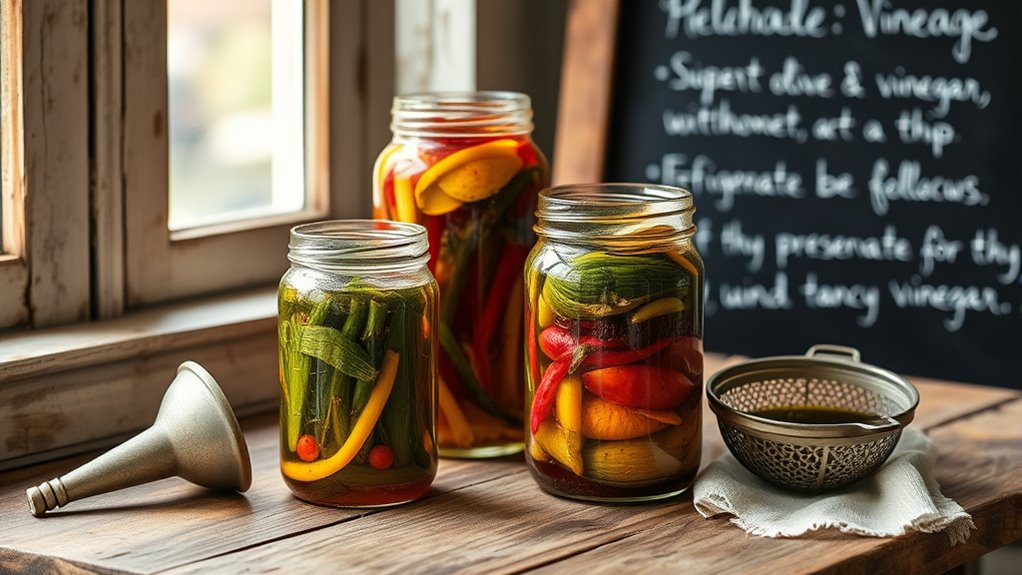
Oil and vinegar are natural preservatives that can extend the shelf life of many foods without refrigeration. You can create flavorful infused dressings and preservation sauces by combining herbs, spices, or garlic with oil or vinegar. These solutions work because the acidity and oil form a barrier against bacteria and mold.
Oil and vinegar naturally preserve foods, extending shelf life without refrigeration.
Imagine:
- Bright red tomatoes submerged in vinegar, intensifying flavor
- Aromatic herbs steeping in olive oil for infused dressings
- Spicy chili flakes infusing into vinegar for a tangy kick
- Homemade preservation sauces with a blend of vinegar and oil for long-lasting flavor
Proper Storage Conditions and Environmental Factors

Maintaining proper storage conditions is essential to preventing spoilage and ensuring the longevity of preserved foods without refrigeration. You need to focus on humidity control by keeping storage areas dry, as excess moisture can lead to mold and bacterial growth. Temperature regulation is equally important; store foods in cool, stable environments away from direct sunlight, which can raise temperatures and accelerate spoilage. Use air-tight containers to limit moisture exposure and maintain consistent conditions. Proper ventilation helps prevent humidity buildup, while insulating storage spaces keeps temperatures steady. Regularly check stored foods for signs of spoilage, adjusting environmental factors as needed. By managing humidity and temperature effectively, you can considerably extend the shelf life of your preserved foods without relying on refrigeration.
Frequently Asked Questions
How Long Can Preserved Foods Typically Last Without Refrigeration?
Without refrigeration, preserved foods can last anywhere from a few days to several months, depending on preservation factors like method and storage conditions. For example, dried or canned foods often last longer, while fresh or fermented items have shorter storage durations. To maximize shelf life, keep the storage environment cool, dry, and away from sunlight. Proper sealing and choosing the right preservation technique are key to extending your food’s storage duration.
Are There Safety Risks Associated With Traditional Preservation Methods?
You should be aware that traditional preservation methods do carry safety risks if not done properly. Poor storage hygiene can lead to food contamination, increasing the chance of harmful bacteria or mold growth. Always verify your preservation techniques are thorough, maintain clean containers and environments, and monitor stored foods regularly. Neglecting these precautions could compromise food safety, so stay vigilant to avoid health issues linked to contaminated or improperly stored preserved foods.
What Are the Best Practices for Avoiding Spoilage During Storage?
To avoid spoilage during storage, you should choose the right storage containers that keep food sealed and protected. Keep your food at a consistent ambient temperature, avoiding extreme heat or cold, which can accelerate spoilage. Store perishable items in cool, dry places, and regularly check for signs of spoilage. Proper organization and rotation of stored food also help guarantee freshness and safety over time.
How Do Different Climates Affect Preservation Techniques?
Different climates considerably impact your preservation techniques due to climate adaptation and preservation challenges. In hot, humid environments, you need methods like drying or fermenting to prevent spoilage, while in cold or dry climates, refrigeration isn’t necessary, but you should focus on airtight storage. Understanding your local climate helps you choose the best preservation methods, ensuring your food stays safe and fresh longer despite environmental challenges.
Can Preserved Foods Retain Their Nutritional Value Over Time?
You might wonder if preserved foods keep their nutritional value over time. In many cases, proper preservation methods enhance nutritional retention and maintain preservation efficacy. However, some nutrients, like vitamins, can degrade gradually. To maximize nutritional benefits, store preserved foods in cool, dark places and consume them within recommended timeframes. This approach helps you enjoy nutritious, safe, and effective preserved foods over longer periods.
Conclusion
By mastering these preservation techniques, you become like a modern-day Noah, safeguarding your bounty against time’s tide. Think of drying, fermenting, and curing as your ark, protecting your food treasures through nature’s methods. With careful storage and environmental awareness, you’ll keep your harvest fresh and ready, just as Noah preserved life. Embrace these timeless skills, and your pantry will flourish, resilient against the unpredictable currents of time.

